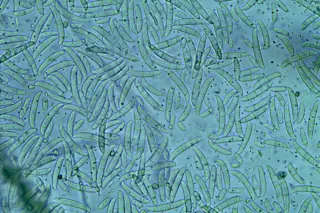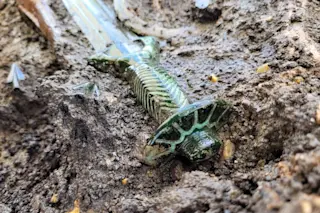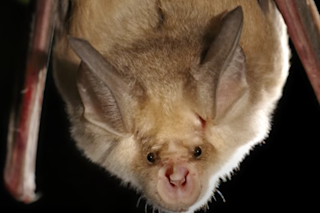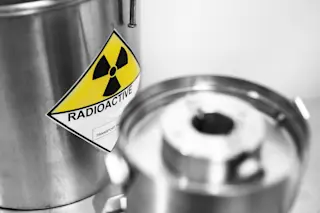In early 1991, several scientists went deep into the Siberian tundra on a covert mission. They worked for a secret laboratory funded by the Soviet government, and they needed a sample of variola major, the virus that causes smallpox.
They headed to a cemetery from the 1800s reserved for smallpox victims and cut deep into the ice. They extracted several corpses still wrapped in caribou fur. The ice had preserved the bodies well, and the scientists took bone and tissue samples, hoping they still contained the virus.
The scientists were looking for a cover. They had been working on smallpox as a possible biological weapon, and now they needed to explain themselves.
Smallpox as a Biological Weapon
When the scientists cut into the Arctic ice, the U.S.S.R. had just been inspected by the World Health Organization (WHO) authorities and unhappy representatives from the U.S. and the U.K. They all demanded to know why the Soviets were working with a virus that had been eradicated more than a decade prior.
Soviet defectors later revealed the truth — the U.S.S.R. had experimented with smallpox as a possible biological weapon. Public health officials had to consider whether the U.S. could withstand such an attack.
It’s a question that scientists are still debating.
What was Smallpox?
One historian described smallpox as a “virus that had plagued humankind for three thousand years.” In 1980, the WHO certified the disease had been eradicated after a successful global vaccination program. Now, there are generations of people who have never known the threat of smallpox.
Smallpox was a disease that could only pass from person to person, making it distinct from viruses that came from animals, insects, or tainted food or water. Scientists mostly agreed that infection came from “respiratory droplet transmission,” meaning a person inhaled the virus.
Once afflicted, a person typically experienced fever and aches as an early symptom. Some had delirium and convulsions. Then, victims’ skin developed red spots that advanced into pus-filled lesions known as pox. One physician described the disease as “hideous and unforgettable.”
Read More: Viruses: What They are, How They Spread, and How We Fight Them
What was it Like to Have Smallpox?
The pox formed everywhere on a person’s body — their eyes, down their throat, and across their skin. Witnesses recall seeing sufferers with so many pox on their faces that their features were no longer identifiable.
After two weeks, the pox usually began to scab. Many who survived had permanent, disfiguring scars. Some went blind. Thirty percent of victims typically died, although there were outbreaks in which the death toll was higher.
How was Smallpox Eradicated?
The last case of smallpox in the U.S. occurred in 1949. However, the disease persisted in many parts of the world.
In the 1960s, the WHO agreed to a global vaccination program to eradicate smallpox. Led by an American physician, the campaign conducted mass vaccinations as well as strict surveillance to identify outbreaks and quarantine people who were possibly infected.
In 1980, the WHO declared smallpox eradicated. Samples of the virus were contained in two laboratories — one in the U.S. and one in the U.S.S.R.
Read More: The First Global Vaccination Expedition Set Sail in 1803
Smallpox as a Weapon of Mass Destruction
For decades, Soviet scientists worked to develop smallpox as a weapon of mass destruction. Most countries, including the U.S., have stopped routine smallpox vaccinations, and the public would be vulnerable.
Soviet scientists experimented with methods for spreading the disease over major metropolitan areas. Their “master plan” first involved the mass production of the smallpox agent. Next, it had to be loaded onto munitions like cluster bombs or intercontinental ballistic missiles. Once detonated over the target, the droplets would form an infectious cloud that would sink upon the unsuspecting victims below.
Could Smallpox Return to the U.S.?
Smallpox is unlikely to return to the U.S. as a naturally occurring event, says Allison Berke, the chemical and biological weapons non-proliferation program director at the Middlebury Institute of International Studies at Monterey.
“We wouldn’t see smallpox as a natural event, but we could see monkeypox, horse pox,” Berke says. “Those viruses are extremely similar; they are something like 98 percent identical.”
There is also the possibility that smallpox could be used for bioterrorism.
“It’s been weaponized before,” Berke says. “It’s been a target of bioweapons programs before. People researching bioweapons programs are going to come across it as a potential candidate.”
Read More: A History of Smallpox Disease and Why It Relates to Monkeypox
Is the U.S. Ready for a Smallpox Attack?
The Centers for Disease Control and Prevention (CDC) says that the Strategic National Stockpile has enough smallpox vaccines for every person in the U.S.
But in 2024, the National Academies issued a report that warned the U.S. was not ready. The report was made at the request of the Administration for Strategic Preparedness and Response, and it raised new concerns.
One of those concerns is that the genetic sequencing of the smallpox virus is publicly available. This means the virus could be recreated, and artificial intelligence could be used to help in the process. One of the report’s authors warned that even one case of smallpox could lead to “a huge global issue.”
U.S. Readiness Against Bioterrorism
The report identifies the U.S.’s vulnerabilities, which Berke says could motivate health officials to be more prepared. But it could also give our adversaries new insight into our weaknesses. “Until we close that gap, it’s additional knowledge for someone who would want to take advantage of that weakness,” Berke says.
Although smallpox is a known threat to scientists, Berke says immediate responses aren’t possible for novel threats. The COVID-19 virus, for example, required months of testing and preparation before vaccines could be rolled out. Then, people had to undergo a series of vaccinations spaced weeks apart to be fully inoculated.
So, although some scientists say the U.S. should be very concerned about smallpox as a weapon of mass destruction, Berke says at least the virus is recognizable, and there is a vaccine stockpile.
“I’m more concerned about other select agents,” she says.
Read More: Ancient Empires Used Bioweapons to Strike Terror More Than 3,000 Years Ago
Article Sources
Our writers at Discovermagazine.com use peer-reviewed studies and high-quality sources for our articles, and our editors review for scientific accuracy and editorial standards. Review the sources used below for this article:
Gove Press. The Once and Future Threat of Smallpox
Hill and Wang. Pox Americana: The Great Smallpox Epidemic of 1775-82
Frontiers in cellular and infection microbiology. What was the primary mode of smallpox transmission? Implications for biodefense
Prometheus Books. Smallpox the death of a disease
CDC. Smallpox Eradication
Chemical and biological weapons non-proliferation program director at the Middlebury Institute of International Studies at Monterey. Allison Berke
National Academies. Future State of Smallpox Medical Countermeasures
Texas A&M Today. Is Smallpox Still A Threat?















